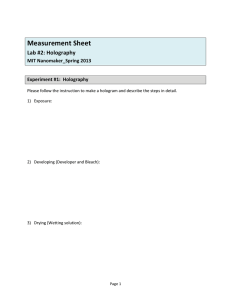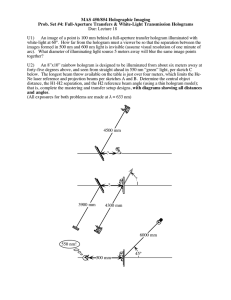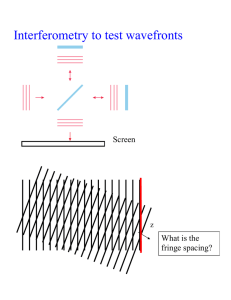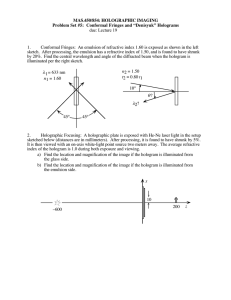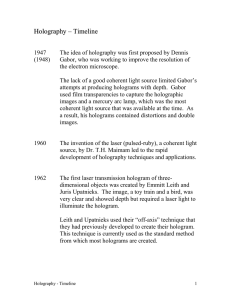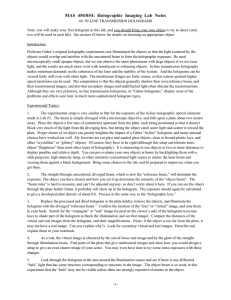IRJET-Mini Review on Holography Methods and Applications
advertisement
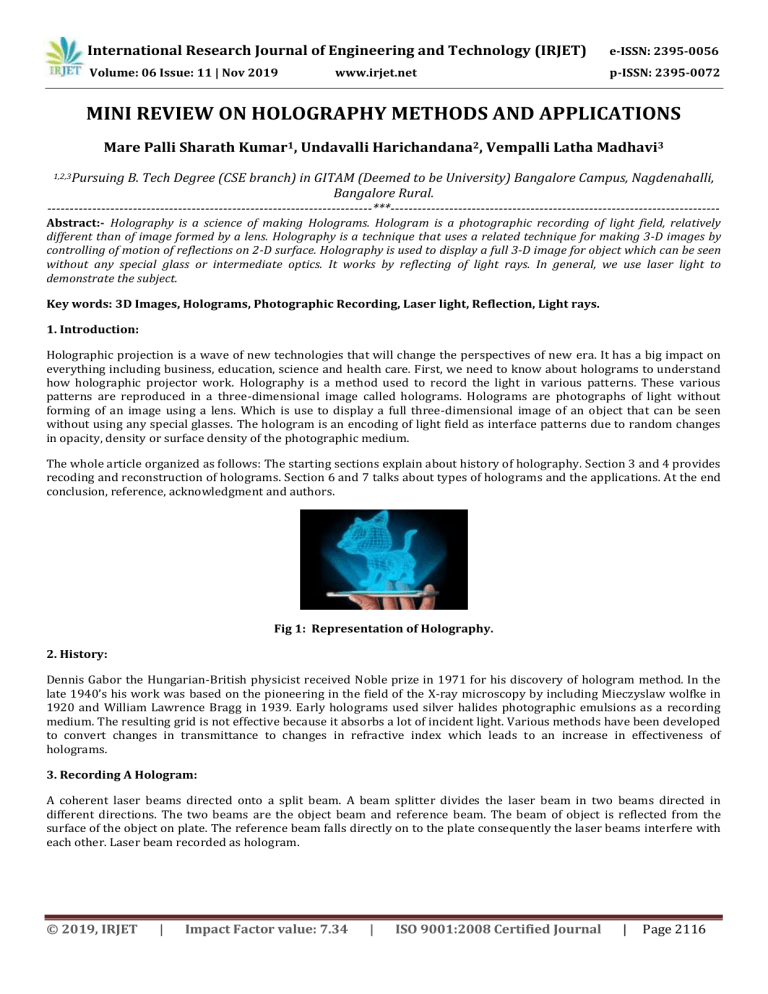
International Research Journal of Engineering and Technology (IRJET) e-ISSN: 2395-0056 Volume: 06 Issue: 11 | Nov 2019 p-ISSN: 2395-0072 www.irjet.net MINI REVIEW ON HOLOGRAPHY METHODS AND APPLICATIONS Mare Palli Sharath Kumar1, Undavalli Harichandana2, Vempalli Latha Madhavi3 1,2,3Pursuing B. Tech Degree (CSE branch) in GITAM (Deemed to be University) Bangalore Campus, Nagdenahalli, Bangalore Rural. ------------------------------------------------------------------------***------------------------------------------------------------------------- Abstract:- Holography is a science of making Holograms. Hologram is a photographic recording of light field, relatively different than of image formed by a lens. Holography is a technique that uses a related technique for making 3-D images by controlling of motion of reflections on 2-D surface. Holography is used to display a full 3-D image for object which can be seen without any special glass or intermediate optics. It works by reflecting of light rays. In general, we use laser light to demonstrate the subject. Key words: 3D Images, Holograms, Photographic Recording, Laser light, Reflection, Light rays. 1. Introduction: Holographic projection is a wave of new technologies that will change the perspectives of new era. It has a big impact on everything including business, education, science and health care. First, we need to know about holograms to understand how holographic projector work. Holography is a method used to record the light in various patterns. These various patterns are reproduced in a three-dimensional image called holograms. Holograms are photographs of light without forming of an image using a lens. Which is use to display a full three-dimensional image of an object that can be seen without using any special glasses. The hologram is an encoding of light field as interface patterns due to random changes in opacity, density or surface density of the photographic medium. The whole article organized as follows: The starting sections explain about history of holography. Section 3 and 4 provides recoding and reconstruction of holograms. Section 6 and 7 talks about types of holograms and the applications. At the end conclusion, reference, acknowledgment and authors. Fig 1: Representation of Holography. 2. History: Dennis Gabor the Hungarian-British physicist received Noble prize in 1971 for his discovery of hologram method. In the late 1940’s his work was based on the pioneering in the field of the X-ray microscopy by including Mieczyslaw wolfke in 1920 and William Lawrence Bragg in 1939. Early holograms used silver halides photographic emulsions as a recording medium. The resulting grid is not effective because it absorbs a lot of incident light. Various methods have been developed to convert changes in transmittance to changes in refractive index which leads to an increase in effectiveness of holograms. 3. Recording A Hologram: A coherent laser beams directed onto a split beam. A beam splitter divides the laser beam in two beams directed in different directions. The two beams are the object beam and reference beam. The beam of object is reflected from the surface of the object on plate. The reference beam falls directly on to the plate consequently the laser beams interfere with each other. Laser beam recorded as hologram. © 2019, IRJET | Impact Factor value: 7.34 | ISO 9001:2008 Certified Journal | Page 2116 International Research Journal of Engineering and Technology (IRJET) e-ISSN: 2395-0056 Volume: 06 Issue: 11 | Nov 2019 p-ISSN: 2395-0072 www.irjet.net Fig 2: Recording a Hologram. 4. Reconstructing A Hologram: The hologram of the laser beam can be reconstructed with the same laser beam as the recording. During hologram reconstruction the beam of object with the tachograph and reference beam touches the opposite sides. To avoid the interface from external light holograms are usually recorded in dark or dark places with cooler different from the laser beam use to produce holograms. In addition, holography requires a certain lighting time which can be controlled by electronic synchronization with a laser. Fig 3: Reconstructing A Hologram. 5. Types of Hologram: 5.1 A Reflection hologram: These holograms are single colour and multicoloured. During recording, reference and object light are opposite in direction. Reflection hologram has to be demonstrated from front with white light of 45 0 angle. Field depth of reflection holograms is smaller when compare with the transmission holograms. Real and virtual images are limited which are 25-30 cm. Reflection holograms have very small amount of natural brightness, so that bleaching is important. Fig 4: Reflection Hologram. 5.2 Transmission Hologram: Transmission holograms is the master or copy hologram. Master hologram can be constructed by using laser light. Copy transmission hologram can be demonstrated using white light. Transmission hologram can be reconstructed using a beam. In transmission hologram object and reference beams are incident in recording medium from equal side. © 2019, IRJET | Impact Factor value: 7.34 | ISO 9001:2008 Certified Journal | Page 2117 International Research Journal of Engineering and Technology (IRJET) e-ISSN: 2395-0056 Volume: 06 Issue: 11 | Nov 2019 p-ISSN: 2395-0072 www.irjet.net Fig 5: Transmission Hologram. 5.3 Phase Hologram: Phase hologram is generated by changing the thickness or the refractive index of a material in proportion to the intensity of holographic interface pattern. Phase hologram can be shown then a plate is lightened up by the original reference beam, it can also be reconstructed by original object. Phase hologram has greater efficiency when compared with amplitude modulated hologram. Fig 6: Phase Hologram. 5.4 Multi-Channel Hologram: Multi-channel hologram developed by using masking and multi exposure methods of hologram patterns. Layers can use more than one holographic plate and can be exposed by using more than one patterns. It provides much flexibility for the artist in terms of manipulating the colour and form. It can be produced by holograms exposed many times with laser light. Fig 7: Multi-Channel Hologram. 5.5 White-Light Transmission Hologram - WLT: WLT hologram is also called as Benton hologram which was developed by Stephen Benton in 1969. This hologram is produced by master hologram. Especially these holograms can be seen in the daylight, these played a very important role in increasing the artistic potential of hologram. Artist started using hologram that can see in daylight, led or ordinary light bulbs without making hologram it can be seen only with the help of laser. © 2019, IRJET | Impact Factor value: 7.34 | ISO 9001:2008 Certified Journal | Page 2118 International Research Journal of Engineering and Technology (IRJET) e-ISSN: 2395-0056 Volume: 06 Issue: 11 | Nov 2019 p-ISSN: 2395-0072 www.irjet.net Fig 8: White-Light Transmission Hologram. 6. Applications of Hologram: Holographic optical elements (HOE) are used to perform the same functions as lenses, gratings, mirrors, etc. It can also combine several functions together not possible with conventional optical elements. Some examples: High resolution spectrometers use holographic gratings. HOE bi-focal contact lenses are manufactured. 6.1 Data storage: It can store the information and data inside the single crystals. 6.2 Dynamic holography: Data storage is a technique which can be store the information of high density inside a crystal. A permanent hologram which is produced by reconstruction and its developing is sequentially. 6.3 Security: Security holograms which are very difficult to copy as they are replica of master holograms. 7. Conclusion: Holography is a modern world technology created for the complete distribution of wave information. The future depends on the hologram. This allows us to maintain an inexpensive approach to the production of equipment. Holography allows you to write different applications for people other than developers and engineers to understand your needs. This technology can be an auxiliary to the fifth sense for differently able people. This technology will bring fundamental changes in the field of science and technology. 8. Reference: [1] Mindaugas, Methods and Applications of Optical Holography. [2] Tung H. Jeong, Basic principles and Applications of Holography, Module 1.10. [3] Gabor, Dennis (1948) “A new microscopic principle”. Nature. 161: p777-778. [4] Gabor, Dennis (1949) “Microscopy by reconstructed wave fronts”. Proceeding of London.197(1051):454-487. the Royal society. [5] Pedrotti, Leno S. and Frank L. Pedrotti, Introduction to Optics, second edition. Prentice-Hall, Inc. 1993. [6] Apple progressing with 3D Holographic Projection Technology (The Macintosh News Network). © 2019, IRJET | Impact Factor value: 7.34 | ISO 9001:2008 Certified Journal | Page 2119 International Research Journal of Engineering and Technology (IRJET) e-ISSN: 2395-0056 Volume: 06 Issue: 11 | Nov 2019 p-ISSN: 2395-0072 www.irjet.net 9. Acknowledgment: We are thankful to DR.CSK RAJU to guide us to improve the quality of the paper and also thankful for the useful suggestion to enhance the paper to further extent. 10. Authors: MARE PALLI SHARATH KUMAR pursuing B. Tech degree (CSE branch) in GITAM (deemed to be university) Bangalore campus. I had published a paper called “REVOLUTION OF 5G WIRELESS TECHNOLOGY-FUTURE DIRECTION” at IOSR JOURNALS OF COMPUTER ENGENEERING VOL 21, ISSUE 4. UNDAVALLI HARICHANDANA pursuing B. Tech degree (CSE branch) in GITAM (deemed to be university) Bangalore campus. I had published a paper called “A STUDY OF ROBOTIC PROCESS AUTOMATION AMONG ARTIFICIAL INTELLIGENCE “at IJSRP PUBLICATIONS VOL 9, ISSUE 2. VEMPALLI LATHA MADHAVI pursuing B. Tech degree (CSE branch) in GITAM (deemed to be university) Bangalore campus. The research are interested in Robotic Process, Artificial Intelligence and Internet of Things. Active in in presenting project presentations. © 2019, IRJET | Impact Factor value: 7.34 | ISO 9001:2008 Certified Journal | Page 2120
